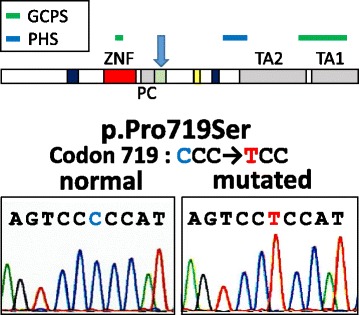Fig. 2.

PCR was conducted with the use of agarose beads from paraffin sections as templates. Each PCR product was cloned into TA-vector, and amplified plasmids were analyzed for the DNA sequence. A missense mutation (c.2155 C > T) leading to p.P719S was detected in 6 of 12 independent clones from PCR targeting exon 6. By this missense mutation, an amino acid property is changed from hydrophobic (Proline, P) to hydrophilic (Serine, S) within the proteolytic cleavage (PC) site of GLI3 (blue arrow in upper panel). Typical location of pathogenic variants of GLI3 gene for GCPS (green bar) and PHS (red bar) are illustrated according to the report by Demurger F et al. [19]
